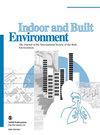Urban heat island phenomenon in Istanbul: A comprehensive analysis of land use/land cover and local climate zone effect
IF 2.9
3区 工程技术
Q2 CONSTRUCTION & BUILDING TECHNOLOGY
引用次数: 0
Abstract
The relationship between urban heat island (UHI) and land use/land cover (LULC), and local climate zone (LCZ) is apparent and takes rising attention in the current literature. This study aimed to investigate the relationship between meteorological data collected from 30 stations between 2016 and 2022 and Istanbul’s LULCs and LCZs. Several notable findings were uncovered, providing light on the UHI phenomenon and its consequences for the city’s characteristics. The stations in urban areas (typology A) had higher temperatures than stations in rural/suburban (typology B) and forested landscape (typology C). Those yearly values were ∼1°C for monthly mean temperatures and ∼1.5°C for monthly minimum temperatures. Moreover, urban areas possessed +4 and +2 hot days (35°C and above) for typologies B and C, respectively. Another remarkable result was that stations situated close to water surfaces exhibited a lower tendency to exceed temperatures of 35°C. Furthermore, built-type LCZs wind velocity achieved a lower value than land cover type, and humidity in typology A was 5% and 10% less than the typologies B and C, respectively. Consequently, the southern part of Istanbul emerged as the most vulnerable location to the UHI phenomena, suffering greater temperatures.伊斯坦布尔的城市热岛现象:对土地利用/土地覆盖和当地气候带效应的综合分析
城市热岛(UHI)与土地利用/土地覆盖(LULC)和当地气候区(LCZ)之间的关系显而易见,并在当前文献中日益受到关注。本研究旨在调查 2016 年至 2022 年期间从 30 个站点收集的气象数据与伊斯坦布尔 LULC 和 LCZ 之间的关系。研究发现了几个值得注意的问题,揭示了超高寒现象及其对城市特征的影响。城市地区(类型 A)的站点温度高于农村/郊区(类型 B)和森林景观(类型 C)的站点。月平均气温的年平均值为 1°C,月最低气温的年平均值为 1.5°C。此外,在类型 B 和类型 C 中,城市地区分别拥有 +4 和 +2 个高温日(35°C 及以上)。另一个值得注意的结果是,靠近水面的站点气温超过 35℃的趋势较低。此外,建筑类型低纬度区的风速值低于土地覆被类型,类型 A 的湿度分别比类型 B 和类型 C 低 5%和 10%。因此,伊斯坦布尔南部地区最容易受到 UHI 现象的影响,温度更高。
本文章由计算机程序翻译,如有差异,请以英文原文为准。
求助全文
约1分钟内获得全文
求助全文
来源期刊

Indoor and Built Environment
环境科学-工程:环境
CiteScore
6.40
自引率
25.00%
发文量
130
审稿时长
2.6 months
期刊介绍:
Indoor and Built Environment publishes reports on any topic pertaining to the quality of the indoor and built environment, and how these might effect the health, performance, efficiency and comfort of persons living or working there. Topics range from urban infrastructure, design of buildings, and materials used to laboratory studies including building airflow simulations and health effects. This journal is a member of the Committee on Publication Ethics (COPE).
 求助内容:
求助内容: 应助结果提醒方式:
应助结果提醒方式:


